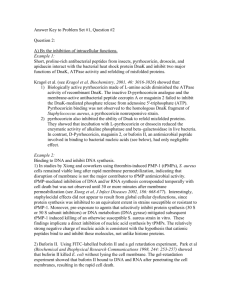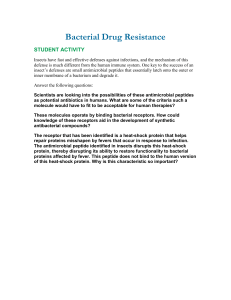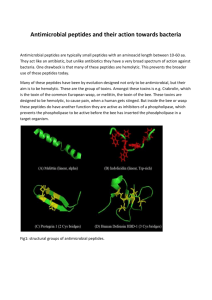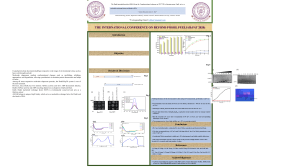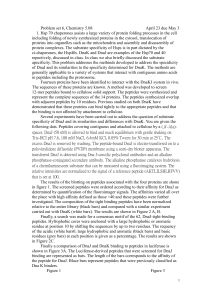Questions
advertisement
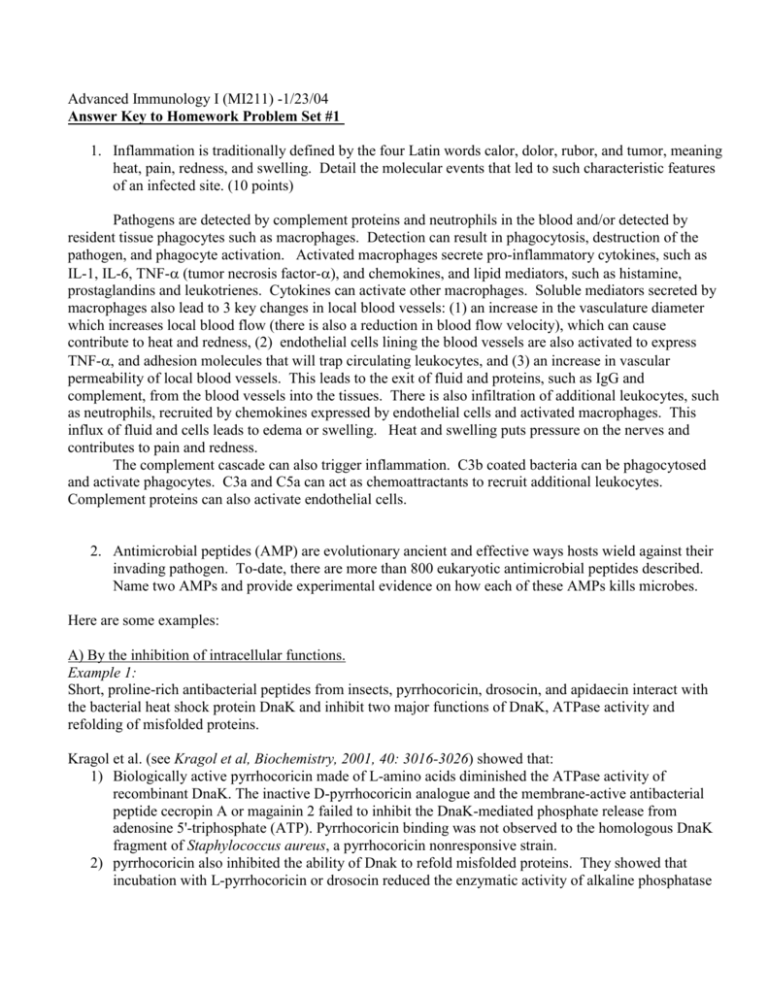
Advanced Immunology I (MI211) -1/23/04 Answer Key to Homework Problem Set #1 1. Inflammation is traditionally defined by the four Latin words calor, dolor, rubor, and tumor, meaning heat, pain, redness, and swelling. Detail the molecular events that led to such characteristic features of an infected site. (10 points) Pathogens are detected by complement proteins and neutrophils in the blood and/or detected by resident tissue phagocytes such as macrophages. Detection can result in phagocytosis, destruction of the pathogen, and phagocyte activation. Activated macrophages secrete pro-inflammatory cytokines, such as IL-1, IL-6, TNF-(tumor necrosis factor-), and chemokines, and lipid mediators, such as histamine, prostaglandins and leukotrienes. Cytokines can activate other macrophages. Soluble mediators secreted by macrophages also lead to 3 key changes in local blood vessels: (1) an increase in the vasculature diameter which increases local blood flow (there is also a reduction in blood flow velocity), which can cause contribute to heat and redness, (2) endothelial cells lining the blood vessels are also activated to express TNF-and adhesion molecules that will trap circulating leukocytes, and (3) an increase in vascular permeability of local blood vessels. This leads to the exit of fluid and proteins, such as IgG and complement, from the blood vessels into the tissues. There is also infiltration of additional leukocytes, such as neutrophils, recruited by chemokines expressed by endothelial cells and activated macrophages. This influx of fluid and cells leads to edema or swelling. Heat and swelling puts pressure on the nerves and contributes to pain and redness. The complement cascade can also trigger inflammation. C3b coated bacteria can be phagocytosed and activate phagocytes. C3a and C5a can act as chemoattractants to recruit additional leukocytes. Complement proteins can also activate endothelial cells. 2. Antimicrobial peptides (AMP) are evolutionary ancient and effective ways hosts wield against their invading pathogen. To-date, there are more than 800 eukaryotic antimicrobial peptides described. Name two AMPs and provide experimental evidence on how each of these AMPs kills microbes. Here are some examples: A) By the inhibition of intracellular functions. Example 1: Short, proline-rich antibacterial peptides from insects, pyrrhocoricin, drosocin, and apidaecin interact with the bacterial heat shock protein DnaK and inhibit two major functions of DnaK, ATPase activity and refolding of misfolded proteins. Kragol et al. (see Kragol et al, Biochemistry, 2001, 40: 3016-3026) showed that: 1) Biologically active pyrrhocoricin made of L-amino acids diminished the ATPase activity of recombinant DnaK. The inactive D-pyrrhocoricin analogue and the membrane-active antibacterial peptide cecropin A or magainin 2 failed to inhibit the DnaK-mediated phosphate release from adenosine 5'-triphosphate (ATP). Pyrrhocoricin binding was not observed to the homologous DnaK fragment of Staphylococcus aureus, a pyrrhocoricin nonresponsive strain. 2) pyrrhocoricin also inhibited the ability of Dnak to refold misfolded proteins. They showed that incubation with L-pyrrhocoricin or drosocin reduced the enzymatic activity of alkaline phosphatase and beta–galactosidase in live bacteria. In contrast, D-Pyrrhocoricin, magainin 2, or buforin II, an antimicrobial peptide involved in binding to bacterial nucleic acids (see below), had only negligible effect. Example 2: Binding to DNA and inhibit DNA synthesis. 1) In studies by Xiong and coworkers using thrombin-induced PMP-1 (tPMPs), S. aureus cells remained viable long after rapid membrane permeabilization, indicating that disruption of membrane is not the major contributor to tPMP antimicrobial activity. tPMP-mediated inhibition of DNA and/or RNA synthesis corresponded temporally with cell death but was not observed until 30 or more minutes after membrane permeabilization (see Xiong et al, J Infect Diseases 2002, 186: 668-677). Interestingly, staphylocidal effects did not appear to result from global cellular dysfunctions, since protein synthesis was inhibited to an equivalent extent in strains susceptible or resistant to tPMP-1. Moreover, pre-exposure to agents that selectively inhibit protein synthesis (30 S or 50 S subunit inhibitors) or DNA metabolism (DNA gyrase) mitigated subsequent tPMP-1 induced killing of an otherwise susceptible S. aureus strain in vitro. These findings implicate a direct inhibition of nucleic acid synthesis by tPMPs. The relatively strong negative charge of nucleic acids is consistent with the hypothesis that cationic peptides bind to and inhibit these molecules, not unlike histone proteins. 2) Buforin II. Using FITC-labelled buforin II and a gel retardation experiment, Park et al (Biochemical and Biophysical Research Communications 1998, 244: 253-257) showed that buforin II killed E. coli without lysing the cell membrane. The gel-retardation experiment showed that buforin II bound to DNA and RNA after penetrating the cell membranes, resulting in the rapid cell death. B) Disruption of physicochemical properties of target membrane. Examples, Magainin (Xenopus skin), tachyplesins (horseshoe crab hemolymph) and cecropin (Drosophila). For a fine review on how the mode of interaction between AMP is strongly dependent on the physicochemical properties of both the peptide and the target membrane, see Matsuzaki, Biochemica et Biophysica Acta 1999, 1462:1-10. Basically, cationic antimicrobial peptides, such as magainin electrostatically recognizes anionic lipids that are abundant in bacterial membranes, forming a peptide-lipid supramolecular complex pore, whereas the peptide does not effectively bind to zwitterionic phospholipids constituting the outer leaflets of mammalian cell membranes because of the low hydrophobicity of the peptide. C) Pore Formation: Pores formed by magainin and protegrin in membranes were directly demonstrated by crystallization, see Yang et al, Biophysical J 2000, 79: 2002-2009.
